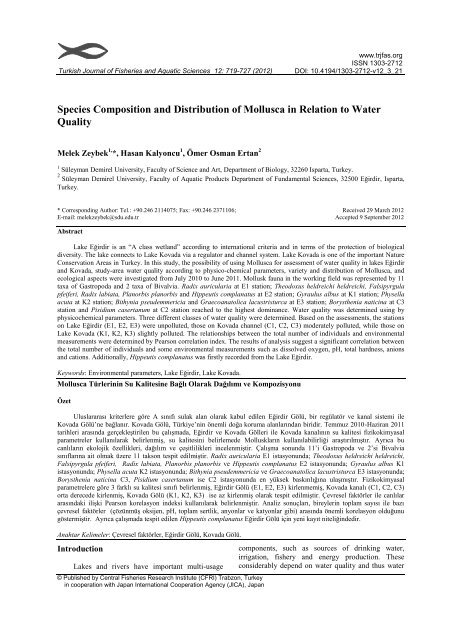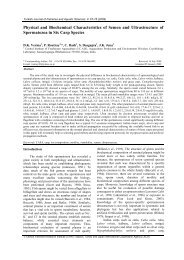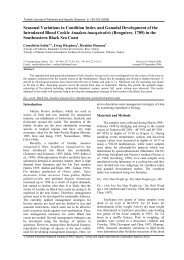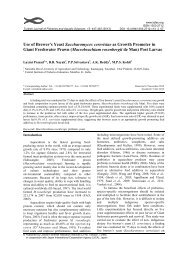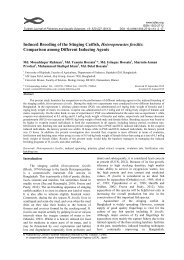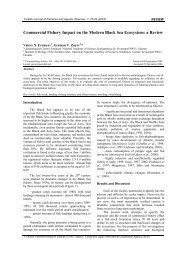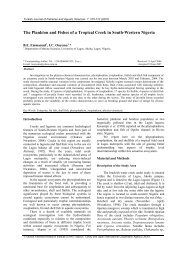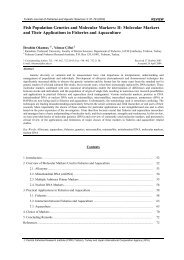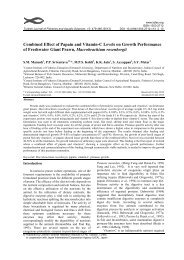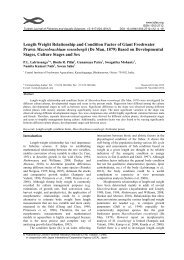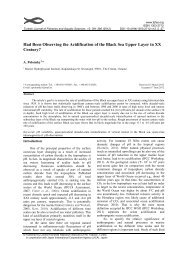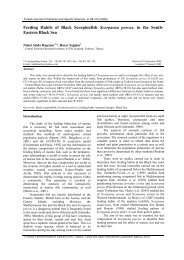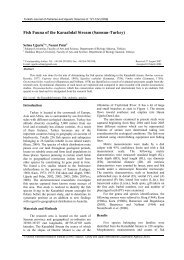Species Composition and Distribution of Mollusca in Relation to ...
Species Composition and Distribution of Mollusca in Relation to ...
Species Composition and Distribution of Mollusca in Relation to ...
Create successful ePaper yourself
Turn your PDF publications into a flip-book with our unique Google optimized e-Paper software.
Turkish Journal <strong>of</strong> Fisheries <strong>and</strong> Aquatic Sciences 12: 719-727 (2012)www.trjfas.orgISSN 1303-2712DOI: 10.4194/1303-2712-v12_3_21<strong>Species</strong> <strong>Composition</strong> <strong>and</strong> <strong>Distribution</strong> <strong>of</strong> <strong>Mollusca</strong> <strong>in</strong> <strong>Relation</strong> <strong>to</strong> WaterQualityMelek Zeybek 1, *, Hasan Kalyoncu 1 , Ömer Osman Ertan 21 Süleyman Demirel University, Faculty <strong>of</strong> Science <strong>and</strong> Art, Department <strong>of</strong> Biology, 32260 Isparta, Turkey.2 Süleyman Demirel University, Faculty <strong>of</strong> Aquatic Products Department <strong>of</strong> Fundamental Sciences, 32500 Eğirdir, Isparta,Turkey.* Correspond<strong>in</strong>g Author: Tel.: +90.246 2114075; Fax: +90.246 2371106;E-mail: melekzeybek@sdu.edu.trReceived 29 March 2012Accepted 9 September 2012AbstractLake Eğirdir is an “A class wetl<strong>and</strong>” accord<strong>in</strong>g <strong>to</strong> <strong>in</strong>ternational criteria <strong>and</strong> <strong>in</strong> terms <strong>of</strong> the protection <strong>of</strong> biologicaldiversity. The lake connects <strong>to</strong> Lake Kovada via a regula<strong>to</strong>r <strong>and</strong> channel system. Lake Kovada is one <strong>of</strong> the important NatureConservation Areas <strong>in</strong> Turkey. In this study, the possibility <strong>of</strong> us<strong>in</strong>g <strong>Mollusca</strong> for assessment <strong>of</strong> water quality <strong>in</strong> lakes Eğirdir<strong>and</strong> Kovada, study-area water quality accord<strong>in</strong>g <strong>to</strong> physico-chemical parameters, variety <strong>and</strong> distribution <strong>of</strong> <strong>Mollusca</strong>, <strong>and</strong>ecological aspects were <strong>in</strong>vestigated from July 2010 <strong>to</strong> June 2011. Mollusk fauna <strong>in</strong> the work<strong>in</strong>g field was represented by 11taxa <strong>of</strong> Gastropoda <strong>and</strong> 2 taxa <strong>of</strong> Bivalvia. Radix auricularia at E1 station; Theodoxus heldreichi heldreichi, Falsipyrgulapfeiferi, Radix labiata, Planorbis planorbis <strong>and</strong> Hippeutis complanatus at E2 station; Gyraulus albus at K1 station; Physellaacuta at K2 station; Bithynia pseudemmericia <strong>and</strong> Graecoana<strong>to</strong>lica lacustristurca at E3 station; Borysthenia natic<strong>in</strong>a at C3station <strong>and</strong> Pisidium casertanum at C2 station reached <strong>to</strong> the highest dom<strong>in</strong>ance. Water quality was determ<strong>in</strong>ed us<strong>in</strong>g byphysicochemical parameters. Three different classes <strong>of</strong> water quality were determ<strong>in</strong>ed. Based on the assessments, the stationson Lake Eğirdir (E1, E2, E3) were unpolluted, those on Kovada channel (C1, C2, C3) moderately polluted, while those onLake Kovada (K1, K2, K3) slightly polluted. The relationships between the <strong>to</strong>tal number <strong>of</strong> <strong>in</strong>dividuals <strong>and</strong> environmentalmeasurements were determ<strong>in</strong>ed by Pearson correlation <strong>in</strong>dex. The results <strong>of</strong> analysis suggest a significant correlation betweenthe <strong>to</strong>tal number <strong>of</strong> <strong>in</strong>dividuals <strong>and</strong> some environmental measurements such as dissolved oxygen, pH, <strong>to</strong>tal hardness, anions<strong>and</strong> cations. Additionally, Hippeutis complanatus was firstly recorded from the Lake Eğirdir.Keywords: Environmental parameters, Lake Eğirdir, Lake Kovada.<strong>Mollusca</strong> Türler<strong>in</strong><strong>in</strong> Su Kalites<strong>in</strong>e Bağlı Olarak Dağılımı ve KompozisyonuÖzetUluslararası kriterlere göre A sınıfı sulak alan olarak kabul edilen Eğirdir Gölü, bir regülatör ve kanal sistemi ileKovada Gölü’ne bağlanır. Kovada Gölü, Türkiye’n<strong>in</strong> önemli doğa koruma alanlarından biridir. Temmuz 2010-Haziran 2011tarihleri arasında gerçekleştirilen bu çalışmada, Eğirdir ve Kovada Gölleri ile Kovada kanalının su kalitesi fizikokimyasalparametreler kullanılarak belirlenmiş, su kalites<strong>in</strong>i belirlemede Molluskların kullanılabilirliği araştırılmıştır. Ayrıca bucanlıların ekolojik özellikleri, dağılım ve çeşitlilikleri <strong>in</strong>celenmiştir. Çalışma sonunda 11’i Gastropoda ve 2’si Bivalviasınıflarına ait olmak üzere 11 takson tespit edilmiştir. Radix auricularia E1 istasyonunda; Theodoxus heldreichi heldreichi,Falsipyrgula pfeiferi, Radix labiata, Planorbis planorbis ve Hippeutis complanatus E2 istasyonunda; Gyraulus albus K1istasyonunda; Physella acuta K2 istasyonunda; Bithynia pseudemmericia ve Graecoana<strong>to</strong>lica lacustristurca E3 istasyonunda;Borysthenia natic<strong>in</strong>a C3, Pisidium casertanum ise C2 istasyonunda en yüksek baskınlığına ulaşmıştır. Fizikokimyasalparametrelere göre 3 farklı su kalitesi sınıfı belirlenmiş, Eğirdir Gölü (E1, E2, E3) kirlenmemiş, Kovada kanalı (C1, C2, C3)orta derecede kirlenmiş, Kovada Gölü (K1, K2, K3) ise az kirlenmiş olarak tespit edilmiştir. Çevresel faktörler ile canlılararasındaki ilişki Pearson korelasyon <strong>in</strong>deksi kullanılarak belirlenmiştir. Analiz sonuçları, bireyler<strong>in</strong> <strong>to</strong>plam sayısı ile bazıçevresel faktörler (çözünmüş oksijen, pH, <strong>to</strong>plam sertlik, anyonlar ve katyonlar gibi) arasında önemli korelasyon olduğunugöstermiştir. Ayrıca çalışmada tespit edilen Hippeutis complanatus Eğirdir Gölü iç<strong>in</strong> yeni kayıt niteliğ<strong>in</strong>dedir.Anahtar Kelimeler: Çevresel faktörler, Eğirdir Gölü, Kovada Gölü.IntroductionLakes <strong>and</strong> rivers have important multi-usage© Published by Central Fisheries Research Institute (CFRI) Trabzon, Turkey<strong>in</strong> cooperation with Japan International Cooperation Agency (JICA), Japancomponents, such as sources <strong>of</strong> dr<strong>in</strong>k<strong>in</strong>g water,irrigation, fishery <strong>and</strong> energy production. Theseconsiderably depend on water quality <strong>and</strong> thus water
720 M. Zeybek et al. / Turk. J. Fish. Aquat. Sci. 12: 719-727 (2012)quality should be kept at a certa<strong>in</strong> level. The pollution<strong>of</strong> surface water with <strong>to</strong>xic chemicals <strong>and</strong> theeutrophication <strong>of</strong> rivers <strong>and</strong> lakes with excessnutrients are areas <strong>of</strong> great environmental concernworldwide. Agricultural, <strong>in</strong>dustrial <strong>and</strong> urbanactivities are considered <strong>to</strong> be major sources <strong>of</strong> theaddition <strong>of</strong> chemicals <strong>and</strong> nutrients <strong>to</strong> aquaticecosystems. Concentrations <strong>of</strong> <strong>to</strong>xic chemicals <strong>and</strong>biologically available nutrients <strong>in</strong> excess can lead <strong>to</strong>such diverse problems as <strong>to</strong>xic algal blooms, loss <strong>of</strong>oxygen, fish kills, loss <strong>of</strong> biodiversity, <strong>and</strong> loss <strong>of</strong>aquatic plants beds <strong>and</strong> coal reefs (Ouyang et al.,2006; İscen et al., 2008).In the determ<strong>in</strong><strong>in</strong>g <strong>of</strong> water quality should beassessed by the use <strong>of</strong> physical, chemical <strong>and</strong>biological parameters <strong>in</strong> order <strong>to</strong> provide a completespectrum <strong>of</strong> <strong>in</strong>formation (Rosenberg <strong>and</strong> Resh, 1993).Benthic macro<strong>in</strong>vertebrates constitute an importantpart <strong>of</strong> aquatic organisms <strong>in</strong> aquatic environments.The aquatic organisms are exposed <strong>to</strong> anthropogenicdisturbance as well as natural changes <strong>in</strong> their habitatswhich are <strong>to</strong> be responded <strong>in</strong> various ways. Therefore,aquatic organisms also have an important role <strong>in</strong>biomoni<strong>to</strong>r<strong>in</strong>g (Rosenberg <strong>and</strong> Resh, 1993; Moorakiet al., 2009). Benthic macro<strong>in</strong>vertebrates are currentlyused <strong>in</strong> lake moni<strong>to</strong>r<strong>in</strong>g <strong>and</strong> diferent <strong>in</strong>dexes wereproposed <strong>to</strong> assess the ecological status <strong>of</strong> lenticecosystems (Wiederholm, 1980). Gastropoda <strong>and</strong>Bivalvia are likely <strong>to</strong> be a common group <strong>of</strong>macrobenthic fauna <strong>in</strong> aquatic ecosystems. Molluscsoccupy a prom<strong>in</strong>ent place among aquatic organismssuitable for biological moni<strong>to</strong>r<strong>in</strong>g (Goldberg, 1986;Salánki, 1989). They react strongly <strong>to</strong> environmentalchanges. This makes them suitable for studies <strong>of</strong> therelationship between organisms <strong>and</strong> environment(Ustaoğlu et al., 2001). The distribution <strong>of</strong> freshwatersnails depend on water quality, e.g. pH, DO, calciumetc. <strong>and</strong> temperature. It has been reported that the<strong>to</strong>xicity <strong>of</strong> most substances is <strong>in</strong>fluenced by suchfac<strong>to</strong>rs as temperature, turbidity, DO, pH, CO 2 <strong>and</strong>water hardness (Okl<strong>and</strong>, 1969; Williams, 1970).Researchers have studied the ecology <strong>of</strong> differentgroups <strong>of</strong> <strong>in</strong>vertebrates, little <strong>in</strong>formation is availableabout the ecology <strong>of</strong> aquatic gastropods <strong>in</strong> <strong>in</strong>l<strong>and</strong>water bodies <strong>of</strong> Turkey (Çabuk et al., 2004; Kalyoncuet al., 2008; Kalyoncu <strong>and</strong> Yıldırım, 2009). In thisstudy, <strong>Mollusca</strong> fauna were determ<strong>in</strong>ed <strong>in</strong> Lakes <strong>of</strong>Eğirdir, Kovada <strong>and</strong> Kovada Channel which havequalitatively <strong>and</strong> quantitavely rich malac<strong>of</strong>auna.Materials <strong>and</strong> MethodsDescription <strong>of</strong> Study AreaLake Eğirdir has a tec<strong>to</strong>nic orig<strong>in</strong> <strong>and</strong> is 929 mabove sea level. It is located at latitude 38°15′ N <strong>and</strong>longitude 30°52′ E <strong>in</strong> The Lake District, southwestTurkey (Figure 1). It has a surface area <strong>of</strong>approximately 482 km 2 <strong>and</strong> maximum depth <strong>of</strong> thelake ranges from 9 m <strong>to</strong>15 m. Northern part <strong>of</strong> thelake is also called as Lake Hoyran. Ma<strong>in</strong> watersources <strong>of</strong> the lake are under ground spr<strong>in</strong>gs, smallstreams <strong>and</strong> ra<strong>in</strong> waters. Especially, most <strong>of</strong> thestreams (e.g. Pupa Stream, Aksu Stream) transportdomestic, agricultural <strong>and</strong> <strong>in</strong>dustrial wastes <strong>to</strong> thelake. Lake Eğirdir is the fourth largest lake <strong>in</strong> surfacearea size (48,800 ha) <strong>in</strong> Turkey. It is located <strong>in</strong> thesouthwestern part <strong>of</strong> Turkey (40°10'N, 28°35'E) at anBLACK SEATURKEYMEDITERRANEANFigure 1. Study area <strong>and</strong> stations.N
M. Zeybek et al. / Turk. J. Fish. Aquat. Sci. 12: 719-727 (2012) 721altitude <strong>of</strong> 918 m above sea level, <strong>and</strong> is amesotrophic lake <strong>of</strong> tec<strong>to</strong>nic orig<strong>in</strong> (Zeybek, 2012).Lake is fed by three major streams (which largely dryup <strong>in</strong> summer) <strong>and</strong> a number <strong>of</strong> spr<strong>in</strong>gs. Lake water isused for irrigation <strong>and</strong> as dr<strong>in</strong>k<strong>in</strong>g water for Isparta<strong>and</strong> Eğirdir. The only outlet is <strong>in</strong> the south wherewater flows the Kovada Lake (Magn<strong>in</strong> <strong>and</strong> Yarar,1997). Lake Eğirdir connects <strong>to</strong> Lake Kovada via aregula<strong>to</strong>r <strong>and</strong> channel system <strong>and</strong> water <strong>of</strong> the lakeflows <strong>to</strong> the Lake Kovada. Because <strong>of</strong> domestic,agricultural <strong>and</strong> <strong>in</strong>dustrial wastes <strong>and</strong> the purifiedwastewater is discharged <strong>in</strong><strong>to</strong> the Kovada channel, thestations on the Kovada Channel were under pressure<strong>of</strong> organic <strong>and</strong> <strong>in</strong>organic pollution (Anonymous,2010).Lake Kovada is one <strong>of</strong> the important nationalparks <strong>in</strong> Turkey. It is a cont<strong>in</strong>uation <strong>of</strong> Lake Eğirdir <strong>to</strong>the south, was formed through the block<strong>in</strong>g <strong>of</strong> thenarrow valley over a long time. Lake Kovada, ly<strong>in</strong>g <strong>to</strong>the east <strong>of</strong> Isparta <strong>and</strong> <strong>to</strong> the south <strong>of</strong> Lake Eğirdir, isthe result <strong>of</strong> the overflow<strong>in</strong>g <strong>of</strong> Lake Eğirdir. Thereare known <strong>to</strong> be Karstic patterns between both <strong>of</strong>these lakes, as well as all around Lake Kovada. Thedeepest part <strong>of</strong> the lake is about 7 m. It is located at analtitude <strong>of</strong> 900 m <strong>and</strong> has a 40 km 2 surface area. Thelength <strong>of</strong> the lake is roughly 9 km <strong>and</strong> the averagewidth is about 2-3 km (Magn<strong>in</strong> et al., 2000).Sampl<strong>in</strong>g was carried out at 9 stations, the locations<strong>of</strong> which are shown <strong>in</strong> the Figure 1, from July 2009 <strong>to</strong>June 2010.Sampl<strong>in</strong>g <strong>of</strong> <strong>Mollusca</strong> <strong>and</strong> Physical <strong>and</strong> ChemicalAnalysisPhysical <strong>and</strong> Chemical AnalysisWater samples for chemical analyses werecollected monthly from each station, us<strong>in</strong>g prewashedpolyethylene bottles. All samples were analyzedwith<strong>in</strong> 24 hours after collection. Water temperature,pH, dissolved oxygen (DO) <strong>and</strong> conductivity weremeasured dur<strong>in</strong>g sampl<strong>in</strong>g <strong>in</strong> the field. Mg +2 , Ca +2 , Cl -, NH 4 + -N, NO 2 - -N, NO 3 - -N, PO 4 - -P, ∑P, COD, BOD<strong>and</strong> <strong>to</strong>tal hardness determ<strong>in</strong>ed <strong>in</strong> the labora<strong>to</strong>ryaccord<strong>in</strong>g <strong>to</strong> St<strong>and</strong>ard methods (Anonymous, 1988).Classification <strong>of</strong> water quality was performedaccord<strong>in</strong>g <strong>to</strong> Klee (1991) <strong>and</strong> Turkish Water PollutionControl Regulation (SKKY, 2008).Samp<strong>in</strong>g <strong>of</strong> <strong>Mollusca</strong>Samples were collected per site monthly (July2010-June 2011) from 9 stations on study area. Thegastropods <strong>and</strong> bivalves were caught by an Ekman-Birge grab <strong>and</strong> the sediments were sieved us<strong>in</strong>g asieve-mesh <strong>of</strong> 0.5 mm. Two hauls <strong>of</strong> bot<strong>to</strong>m sedimentwere taken from each sampl<strong>in</strong>g site with an Ekman-Birge grab, which covered a surface area <strong>of</strong> 225 cm 2 .Only liv<strong>in</strong>g organisms were considered. The materialswere preserved <strong>in</strong> 70% ethyl alcohol. In thelabora<strong>to</strong>ry, they were identified <strong>and</strong> counted under a10x magnification b<strong>in</strong>oculer microscope. Sampleswere identified <strong>to</strong> species level us<strong>in</strong>g taxonomic keys(Schütt, 1964;1965; Geldiay <strong>and</strong> Bilg<strong>in</strong>, 1969; Macan,1977; Bilg<strong>in</strong>, 1980; Schütt <strong>and</strong> Şeşen, 1989; Yıldırım,1999; 2004). All collected materials were kept <strong>in</strong> theHydrobiology Labora<strong>to</strong>ry <strong>of</strong> Art <strong>and</strong> SciencesFaculty, Süleyman Demirel University. Dom<strong>in</strong>ance<strong>and</strong> frequency were used for the numerical analysis.Correlations between environmental parameters <strong>and</strong>mollusca were determ<strong>in</strong>ed by Pearson’s correlationcoefficients.Results <strong>and</strong> DiscussionsAccord<strong>in</strong>g <strong>to</strong> physical <strong>and</strong> chemical parameters,three different water quality levels were observed <strong>in</strong>the study area. E1, E2 <strong>and</strong> E3 stations wereunpolluted or slightly polluted, C1, C2 <strong>and</strong> C3moderately polluted, K1, K2 <strong>and</strong> K3 slightly pollutedaccord<strong>in</strong>g <strong>to</strong> Klee (1991) <strong>and</strong> SKKY (2008).Accord<strong>in</strong>g <strong>to</strong> physicochemical parameters, the resultsobta<strong>in</strong>ed seem <strong>to</strong> support each other. Because <strong>of</strong>domestic, agricultural <strong>and</strong> <strong>in</strong>dustrial wastes <strong>and</strong> thepurified wastewater is discharged <strong>in</strong><strong>to</strong> the Kovadachannel, the stations on the Kovada channel wereunder pressure <strong>of</strong> organic <strong>and</strong> <strong>in</strong>organic pollution(Anonymous, 2010). So, most <strong>of</strong> the physicochemicalparameters were recorded <strong>to</strong> be high relatively otherstations (Table 1).In the present <strong>of</strong> <strong>Mollusca</strong> were identified, 11taxa belong<strong>in</strong>g <strong>to</strong> Gastropoda <strong>and</strong> 2 taxa belong<strong>in</strong>g <strong>to</strong>Bivalvia. Dreissena polymorpha ana<strong>to</strong>lica(Bourguignat, 1884) was determ<strong>in</strong>ed as only valva.So, they were not evaluated <strong>in</strong> relation <strong>to</strong> waterquality. A <strong>to</strong>tal <strong>of</strong> 17305 <strong>in</strong> per square meter (<strong>in</strong>d.m -2 )mollusca species were collected <strong>in</strong> this study. Thedom<strong>in</strong>ant species <strong>of</strong> the mollusca community <strong>in</strong> thestudy area are shown <strong>in</strong> Table 2. Of the gastropods,T.h. heldreichi (Martens 1879), B. natic<strong>in</strong>a (Menke1845), G. lacustristurca Radoman 1973, F. pfeiferi(Weber, 1927), B. pseudemmericia (Schütt 1964) arebelong<strong>in</strong>g <strong>to</strong> Prosobranchia; while R. auricularia(L<strong>in</strong>naeus 1758), R. labiata (O. F. Müller 1774), H.complanatus (L<strong>in</strong>naeus 1758), G. albus (O. F. Müller1774), P. planorbis (L<strong>in</strong>naeus, 1758), P. acuta(Draparnaud, 1805) <strong>to</strong> order Pulmonata. P.casertanum (Poli 1791) <strong>to</strong> Sphaeriidae <strong>and</strong> D.polymorpha ana<strong>to</strong>lica (Bourguignat 1884) <strong>to</strong>Dreissenidae family <strong>of</strong> Bivalvia.The mean densities <strong>of</strong> <strong>Mollusca</strong> at n<strong>in</strong>e sampl<strong>in</strong>gsites were differed from each other. The highest me<strong>and</strong>ensities <strong>of</strong> <strong>Mollusca</strong> were observed at E1, E3 <strong>and</strong> E2stations (Table 3). The most abundant species <strong>in</strong> thesampl<strong>in</strong>g area through out the study period were B.natic<strong>in</strong>a, G. albus <strong>and</strong> P. acuta.Temperature ranged between 3.6-27.1°C, <strong>and</strong> nosignificant correlation with mollusca species <strong>in</strong> thisstudy area. B. pseudemmericia, F. pfeiferi, H.complanatus, R. auricularia were positively
722 M. Zeybek et al. / Turk. J. Fish. Aquat. Sci. 12: 719-727 (2012)Table 1. Average values <strong>of</strong> water quality parameters <strong>and</strong> classes correspond<strong>in</strong>g <strong>to</strong> levels (Average±SE; m<strong>in</strong>-max)Parameter E1 E2 E3 C1 C2 C3 K1 K2 K3Temp. (°C) 15.9±2.384.5-27.115.8±2.344.5-26.715.8±2.344.7-26.716.2±2.086.3-25.116.2±2.136.3-25.616.3±2.165.9-25.315.2±2.133.6-24.415.2±2.093.7-23.915.3±2.123.9-24.1DO (mg/L) 7.80±0.286.76-9.57.58±0.286.1-8.987.54±0.236.5-8.793.87±0.262.63-4.804.59±0.303.27-6.85.23±0.333.92-7.37.61±0.216.57-8.668.18±0.397.09-11.387.96±0.217.19-9.15pH 8.87±0.118.3-9.669.07±0.128.51-9.719.2±0.148.6-9.958.41±0.127.62-9.108.49±0.157.98-9.38.56±0.137.97-9.238.72±0.147.72-9.588.88±0.148.26-9.608.65±0.157.9-9.46EC (µS/cm) 309.3±8.61261.7-343.7312.0±9.47261.7-357.5310.8±8.76261.1-345.9428.7±26.20363.9-644386.0±5.18359.0-422.5378.1±9.47322.1-422.7259.4±5.89230.6-290.2250.8±8.55204.9-290.4264.5±6.63231.1-291.8Ca ++ (mg/L) 28.37±1.4123.56-40.6428.38±1.7523.24-44.2028.3±1.1824.54-38.4453.11±5.7726.75-87.2852.58±4.3428.24-68.5751.47±4.6028.41-67.5531.59±2.6416.46-42.0729.34±3.0916.22-43.1131.92±2.6915.87-43.73Mg ++ (mg/L) 31.93±0.3030.32-33.4632.04±0.2730.92-34.0731.86±0.2730.75-33.229.20±1.1919.00-32.2227.41±1.6218.40-32.1426.94±1.5218.90-33.1819.98±0.5417.46-23.9619.60±0.6215.76-23.4920.63±0.6518.26-24.66Cl - (mg/L) 8.42±0.536.33-11.808.47±0.905.80-16.308.01±0.486.38-11.213.75±0.997.62-18.0012.11±0.697.89-16.3011.15±0.648.34-14.607.75±0.416.08-10.708.27±0.496.15-11.208.13±0.496.12-12.10NH 4-N (mg/L) 0.08±0.01UDL-0.130.09±0.01UDL-0.180.06±0.01UDL-0.111.20±0.310.17-3.000.92±0.210.17-2.090.77±0.170.10-1.530.13±0.020.07-0.230.13±0.020.06-0.280.13±0.02UDL-0.22NO 2-N (mg/L)0.02±0.01 0.02±0.00 0.03±0.01 0.01±0.000.01±0.00UDL* UDL * UDL *UDL *UDL-0.07 UDL-0.05 UDL-0.05 UDL-0.02UDL-0.02NO 3-N (mg/L) 1.15±0.12UDL-2.101.22±0.13UDL-2.101.28±0.19UDL-2.61.95±0.73UDL-9.201.47±0.40UDL-5.401.55±0.29UDL-4.201.16±0.12UDL-2.201.25±0.17UDL-2.801.22±0.15UDL-2.30PO 4-P (mg/L) 0.05±0.01UDL-0.100.06±0.02UDL-0.220.05±0.00UDL-0.050.33±0.10UDL-0.990.19±0.04UDL-0.450.24±0.12UDL-1.420.11±0.03UDL -0.370.16±0.06UDL -0.730.29±0.21UDL-2.42∑P (mg/L) 0.06±0.01UDL-0.100.07±0.01UDL-0.150.06±0.02UDL-0.210.44±0.110.05-1.070.28±0.040.12-0.570.29±0.130.09-1.540.13±0.04UDL-0.420.13±0.03UDL-0.310.32±0.21UDL-2.45COD (mg/L) 21.27±2.0410.0-36.025.09±2.3713.0-41.020.18±2.2810.0-30.032.36±3.2510.0-42.025.64±2.2610.0-38.021.91±3.1510.0-39.023.64±2.5913.0-41.026.45±3.8610.0-52.022.27±2.8010.0-43.0BOD (mg/L) 1.64±0.311.0-4.01.55±0.251.0-3.01.36±0.241.0-3.03.45±0.791.0-9.02.73±0.541.0-7.03.00±0.431.0-5.02.45±0.411.0-5.02.36±0.242.0-4.02.18±0.301.0-4.0TH (°dH) 12.00±0.2111.09-13.1012.37±0.2011.09-13.1012.00±0.1611.09-13.1015.76±0.8412.10-20.1614.66±0.5512.10-17.1414.75±0.5812.10-18.149.71±0.537.06-12.109.26±0.636.05-12.109.90±0.477.06-12.10SKKY (2008) II-slightly polluted III-polluted II-slightly pollutedWaterQualityClassesKlee (1990) I-oligosaprob II-betamesosaprob I-II oligo/betamesosaprob*The measured values for all analysis are under the limits <strong>of</strong> analysis (UDL: under the limits <strong>of</strong> analysis)Table 2. Dom<strong>in</strong>ancy <strong>of</strong> <strong>Mollusca</strong> species <strong>in</strong> stationsGastropodaBivalviaTaxaSTATIONSE1 E2 E3 C1 C2 C3 K1 K2 K3ProsobranchiaNerit<strong>in</strong>imorphaTheodoxus h.heldreichi (Martens 1879) 6.19 6.80 6.62 4.54 3.70 3.85 - - 3.22CaenogastropodaBithynia pseudemmericia Schütt 1964 14.2 11.5 14.5 - 3.70 - - - 8.06G. lacustristurca Radoman 1973 10.9 8.16 16.5 - 7.40 12.82 - - -NeotaenioglossaFalsipyrgula pfeiferi (Weber 1927) 12.8 13.6 11.9 - - 1.28 - - 4.83AllogastropodaBorysthenia natic<strong>in</strong>a (Menke 1845) 13.8 11.5 11.2 22.72 31.48 34.62 30.7 9.6 19.35PulmonataRadix auricularia (L<strong>in</strong>naeus 1758) 15.7 10.2 10.6 4.54 - 1.28 - - 1.61Radix labiata (O. F. Müller 1774) 6.67 6.80 5.30 - - - - 3.23 -Physella acuta (Draparnaud 1805) 1.90 4.76 4.64 40.90 31.48 20.23 19.2 51.6 30.64Planorbis planorbis (L<strong>in</strong>naeus 1758) 2.86 3.40 0.66 - 1.85 1.28 - - -Gyraulus albus (O. F. Müller 1774) 2.38 7.48 4.64 27.27 12.96 25.64 50.0 35.4 32.25Hippeutis complanatus (L<strong>in</strong>naeus 1758) 11.4 14.9 11.9 - - - - - -SphaeriidaePisidium casertanum (Poli 1791) 0.95 0.68 1.32 - 7.40 1.28 - - -correlated with DO values (P
M. Zeybek et al. / Turk. J. Fish. Aquat. Sci. 12: 719-727 (2012) 723Table 3. Mean density <strong>of</strong> <strong>in</strong>dividuals (<strong>in</strong>d. m -2 ) <strong>of</strong> <strong>Mollusca</strong> samples <strong>in</strong> the study areaStationMe<strong>and</strong>ensity <strong>of</strong><strong>to</strong>tal<strong>Mollusca</strong>(<strong>in</strong>d. m -2 )T.h. heldreichiB. pseudemmericiaF. pfeiferiG. lacustristurcaB. natic<strong>in</strong>aE1 4662 288 666 600 511 644 733 311 88 133 111 533 44E2 3261 222 377 444 266 377 333 222 155 111 244 488 22E3 3350 222 488 400. 555 377 355 177 155 22 155 400 44C1 488 22 - - - 111 22 - 200 - 133 - -C 1175 44 44 - 88 377 - - 377 2 155 - 88C3 1731 66 - 22 222 600 22 - 311 22 444 - 22K1 576 - - - - 177 - - 111 - 288 - -K2 687 - - - - 66 - 22 355 - 244 - -K3 1375 44 111 66 - 266 22 - 422 - 444 - -Total 17305 908 1686 1532 1642 2995 1487 732 2174 290 2218 1421 220R..auriculariaR.. labiataP. acutaP. planorbisG.albusH. complanatusP. casertanum(P
724 M. Zeybek et al. / Turk. J. Fish. Aquat. Sci. 12: 719-727 (2012)Table 4. Correlation between <strong>Mollusca</strong> species <strong>and</strong> water quality parameters°C DO pH EC Ca ++ Mg ++ Cl - NH 4-N NO 2-N NO 3-N PO 4-P ∑P COD BOD THT.h. heldreichi NS NS .222 * NS NS .323 ** NS NS NS NS NS NS NS NS .213*B. pseudemmercia NS .269 ** .299 ** NS -.312 ** .458 ** NS -.274 ** -.202 * NS NS NS -.242 * -.272 ** NSF. feifferi NS .345 ** .353 ** NS -.357 ** .532 ** -.301 ** -.321 ** -.259 ** NS NS -.199 * -.214 * -.274 ** NSG. lacustriturca NS .220 * .290 ** NS NS .382 ** NS NS NS NS NS NS NS -.239 * NSB. natic<strong>in</strong>a NS NS NS NS NS .236 * NS NS NS NS NS NS NS NS NSR. auricularia NS .320 ** .271 ** NS -.329 ** .523 ** -.288 ** -.297 ** -.241 * NS -.238 * -.264 ** NS -.288 ** NSR. labiata NS .209 * NS NS -.282 ** .445 ** -.236 * -.282 ** -.215 * NS -.207 * -.252 * -.203 * -.201 * NSH. complanatus NS .356 ** .363 ** NS -.338 ** .532 ** -.235 * -.295 ** -.231 * NS -.222 * -.252 * -.204 * -.348 ** NSG. albus NS NS NS NS NS -.207 * NS NS NS NS NS NS NS NS NSP. planorbis NS NS NS NS NS .227 * NS NS NS NS NS NS NS NS NSP. acuta NS NS NS NS NS NS NS NS NS NS NS NS NS NS NSP. casertanum NS NS NS NS NS NS NS NS NS NS NS NS NS NS NS** . Correlation is significant at the 0.01 level (2-tailed); * . Correlation is significant at the 0.05 level (2-tailed) N: 108; NS: Not significantTable 5. Frequency levels for each station (%)GastropodaTaxaFrequency levels for each station (%)E1 E2 E3 C1 C2 C3 K1 K2 K3ProsobranchiaNerit<strong>in</strong>imorphaTheodoxus h. heldreichi 91.67 91.67 66.67 8.33 16.67 25.00 - - 16.67CaenogastropodaBithynia pseudemmericia 91.67 91.67 100.00 - 8.33 - - - 8.33G. lacustristurca 91.67 83.33 100.00 - 16.67 41.67 - - -NeotaenioglossaFalsipyrgula pfeiferi 91.67 91.67 100.00 - - 8.33 - - 16.67AllogastropodaBorysthenia natic<strong>in</strong>a 83.33 83.33 83.33 33.33 58.33 91.67 25.00 33.33 33.33PulmonataRadix auricularia 100.00 91.67 100.00 8.33 - 8.33 - - 8.33Radix labiata 83.33 83.33 66.67 - - - - 8.33 -Hippeutis complanatus 83.33 91.67 91.67 - - - - - -Gyraulus albus 25.00 66.67 50.00 25.00 33.33 41.67 50.00 66.67 66.67Planorbis planorbis 41.67 16.67 8.33 - 8.33 8.33 - - -Physella acuta 33.33 16.67 41.67 41.67 66.67 83.33 25.00 83.33 66.67Bivalvia SphaeriidaePisidium casertanum 16.67 8.33 16.67 - 33.33 8.33 - - -flow.B. natic<strong>in</strong>a, has Pontic-Baltic distribution <strong>in</strong>lakes (Glöer, 2002) <strong>and</strong> its distribution <strong>in</strong> Turkey<strong>in</strong>cludes the Mediterranean (Yıldırım, 1999). B.natic<strong>in</strong>a showed a significant correlation with onlyMg +2 (P
M. Zeybek et al. / Turk. J. Fish. Aquat. Sci. 12: 719-727 (2012) 725Karaşah<strong>in</strong>, 2004; Yıldırım et al., 2006a). Çabuk et al.(2004) <strong>and</strong> Gallordo et al. (1994) determ<strong>in</strong>ed G. albus<strong>in</strong> polluted waters. In this study, G. albus was foundat all stations.Accord<strong>in</strong>g <strong>to</strong> Çabuk et al. (2004) <strong>and</strong> Kalyoncuet al. (2009), G. albus <strong>and</strong> P. acuta are the most<strong>to</strong>lerant taxon <strong>and</strong> can be found <strong>in</strong> all the determ<strong>in</strong>edwater quality classes. Our f<strong>in</strong>d<strong>in</strong>gs support thisknowledge. In this study, G. albus, P. acuta <strong>and</strong>addia<strong>to</strong>nally B. natic<strong>in</strong>a was observed <strong>in</strong> all thestations.H. complanatus was found only at stations <strong>of</strong>Lake Eğirdir (E1, E2, E3) <strong>and</strong> showed positivecorrelation with DO, pH, Mg, (P
726 M. Zeybek et al. / Turk. J. Fish. Aquat. Sci. 12: 719-727 (2012)Herr<strong>in</strong>g<strong>to</strong>n, H.B. 1962. A Revision <strong>of</strong> the Sphaeriidae <strong>of</strong>North America, (<strong>Mollusca</strong>: Pelecypoda).Miscellaneous Publications <strong>of</strong> the Museum <strong>of</strong>Zoology, 118: 1-81.İscen, C.F., Emiroglu, Ö., İlhan, S., Arslan, N., Yılmaz, V.<strong>and</strong> Ahıska, S. 2008. Application <strong>of</strong> multivariatestatistical techniques <strong>in</strong> the assessment <strong>of</strong> surfacewater quality <strong>in</strong> Uluabat Lake. Turk. Environ. Monit.Assess., 144 (1-3): 269-276.doi: 10.1007/s10661-007-9989-3Kalyoncu, H., Barlas, M., Yıldırım, M.Z. <strong>and</strong> Yorulmaz, B.2008. Gastropods <strong>of</strong> Two Important Streams <strong>of</strong>Gökova Bay (Muğla,Turkey) <strong>and</strong> Their <strong>Relation</strong>shipswith Water Quality. International Journal <strong>of</strong> Science<strong>and</strong> Technology, 3(1): 27-36.Kalyoncu, H. <strong>and</strong> Yıldırım, M.Z. 2009. <strong>Species</strong>composition <strong>of</strong> the <strong>Mollusca</strong> <strong>in</strong> Aksu River System(Turkey) <strong>and</strong> its relation <strong>to</strong> water quality. FreseniusEnvironmental Bullet<strong>in</strong>, 18(8): 1446-1451.Kebapçı, Ü. <strong>and</strong> Yıldırım, M.Z. 2010. Freshwater snailsfauna <strong>of</strong> lakes region, Turkey. Muzeul OltenieiCraiova. Oltenia. Studii şi comunicãri. Şti<strong>in</strong>ţeleNaturii. Tom., 26 (2): 75-83.Klee, O. 1991. Angew<strong>and</strong>te Hydrobiologie. G. TheiemeVerlag, 2. neubearbeitete und erweiterte Auflage,Stuttgart-New York.Koşal-Şah<strong>in</strong>, S. <strong>and</strong> Yıldırım, M.Z. 2007. The MolluscFauna <strong>of</strong> Lake Sapanca (Turkey: Marmara) <strong>and</strong> SomePhysico-Chemical Parameters <strong>of</strong> Their Abundance.Tr. J. <strong>of</strong> Zoology, 31: 47-52.Macan, T.T. 1977. A Key <strong>to</strong> the British Fresh <strong>and</strong> BrackishWater Gastropods. Scientific Publication <strong>of</strong> theFreshwater Biological Association no. 13. FreshwaterBiological Association, Scientific Publication,Ambleside, 46 pp.Magn<strong>in</strong>, G. <strong>and</strong> Yarar, M. 1997. Important bird breed<strong>in</strong>gareas <strong>in</strong> Turkey. The Society for the ProtectionNature, 50–52.Magn<strong>in</strong>, G., Eken, M. <strong>and</strong> Yarar, M. 2000. Turkey. In: M.F.Heath <strong>and</strong> M.I. Evans (Eds.), Important Bird Areas <strong>in</strong>Europe: Priority Sites for Conservation, 2: SouthernEurope. (BirdLife Conservation Series). BirdLifeInternational, Cambridge, UK: 651-689.Meyer, D. 1987. Makroskopisch-Biologische Feldmethodenzur Wassergütebeurteilung von Flieβgewässern.3.Auflage, A.L.G., Hannover: 140 pp.Mooraki, N., Esmaeli-Sari, A., Soltani, M. <strong>and</strong> Val<strong>in</strong>assab,T. 2009. Spatial distribution <strong>and</strong> assemblage structure<strong>of</strong> macrobenthos <strong>in</strong> a tidal creek <strong>in</strong> relation <strong>to</strong><strong>in</strong>dustrial activities. Int. J. Environ. Sci. Tech., 6(4):651-662.Okl<strong>and</strong>, J. 1969. <strong>Distribution</strong> <strong>and</strong> ecology <strong>of</strong> freshwatersnails (Gastropoda) <strong>of</strong> Norway. Malacologia, 9: 143-151.Ouyang, Y., Nkedi-Kizza, P., Wu, Q. T., Sh<strong>in</strong>de, D. <strong>and</strong>Huang, C. H. 2006. Assessment <strong>of</strong> seasonal variations<strong>in</strong> surface water quality. Water Research, 40: 3800–3810. doi: 10.1016/j.watres.2006.08.030Pfleger, V. 1999. A Field Guide <strong>in</strong> Colour <strong>to</strong> Molluscs.Blitz Editions. Leicesteri U.K., 216 pp.Radoman, P. 1973. On the relations some Freshwater<strong>Mollusca</strong> <strong>of</strong> the Balkan Pen<strong>in</strong>sula <strong>and</strong> Asia M<strong>in</strong>or.Basteria, 37: 77-84.Ramakrishna, D.A. 2007. H<strong>and</strong>book on Indian FreshwaterMolluscs. Kolkata: Zoological Survey <strong>of</strong> India,Kolkata, 399 pp.Rosenberg, D.M. <strong>and</strong> Resh, V.H. 1993. Freshwaterbiomoni<strong>to</strong>r<strong>in</strong>g <strong>and</strong> benthic macro<strong>in</strong>vertebrates.Chapman <strong>and</strong> Hall, New York, 488 pp.Roth, G. 1987. Data on the <strong>Distribution</strong> <strong>and</strong> Faunal His<strong>to</strong>ry<strong>of</strong> the Genus Theodoxus <strong>in</strong> the Middle East(Gastropoda: Neritidae). Dr. Ludwig Reichert VerlagWeisbaden: 72-79.Salánki, J. 1989. New avenues <strong>in</strong> the biological <strong>in</strong>dication<strong>of</strong> environmental pollution. Acta. Biol. Acad. Sci.Hung., 40: 295-328.Schütt, H. 1964. Die Molluskenfauna e<strong>in</strong>es reliktarenQuellsees der Südlichen Türkei. Arch.Molluskenkunde, 93(5/6): 173-180.Schütt, H. 1965. Zur Systematik und Ökologie TürkischerSüßwasserprosobranchier. Zool. Meded., 41(3): 44-72.Schütt, H. <strong>and</strong> Şeşen, R. 1989. Theodoxus <strong>in</strong> South-easternAna<strong>to</strong>lia, Turkey (Gastropoda Prosobranchia,Neritidae). Basteria, 53: 39-46.Schütt, H. 1990. Die Pleis<strong>to</strong>zanen Mollusken dreierPisidischer Salzseen. Mit. Dts. Malakozool, 46: 15-24.Schütt, H. 1991. Fossile Mollusken dreier Ana<strong>to</strong>lischerOvas. Arch. Moll., 120(4/6): 131-147.Schütt, H. 1993. Pseudamnicola species <strong>and</strong> otherfreshwater gastropods (<strong>Mollusca</strong>, Gastropoda) fromEast Ana<strong>to</strong>lia (Turkey), the Ukra<strong>in</strong>e <strong>and</strong> the Lebanon.Basteria, 57: 161-171.Subba Rao, N.V. 1989. H<strong>and</strong>book <strong>of</strong> Freshwater Molluscs<strong>of</strong> India. Zoological Survey <strong>of</strong> India, Culcutta, 289 pp.Thorp, J.H. <strong>and</strong> Covich, A.P. 2001. Ecology <strong>and</strong>Classification <strong>of</strong> North American FreshwaterInvertebrates, Academic Press, 2: 850-870.doi: 10.1016/B978-012690647-9/50002-8Turkish Water Pollution Control Regulation (SKKY), 2008.The Regulation <strong>of</strong> Water Pollution Control. M<strong>in</strong>istry<strong>of</strong> Environment <strong>and</strong> Forestry. Official Newspaper,February, 2008, No. 26786.Ustaoğlu, M.R., Balık, S. <strong>and</strong> Özbek, M. 2001. Işıklı Gölü(Çivril-Denizli)’nün <strong>Mollusca</strong> Faunası, E.U. Journal<strong>of</strong> Fisheries <strong>and</strong> Aquatic Sciences, 18(1-2): 135-139.Weber, A. 1927. E<strong>in</strong>e neue Pyrgula, Pyrgula pfeiferi m.Zool. Anz., 70: 313-314.Wiederholm, T. 1980. Use <strong>of</strong> benthos <strong>in</strong> lake moni<strong>to</strong>r<strong>in</strong>g.Journal Water Pollution Control Federation, 52: 537-547. doi: 10.1007/BF00018827Williams, N.V. 1970. Studies on aquatic pulmonate snails <strong>in</strong>central Africa. I. Field distribution <strong>in</strong> relation <strong>to</strong> waterchemistry. Malacologia, 10: 153-164.Yıldırım, M.Z. <strong>and</strong> Şeşen, R. 1994. Burdur ve Ispartacivarındaki bazı tatlısulardan <strong>to</strong>planan mollusca türleriüzer<strong>in</strong>de zoocoğrafik ve taksonomik araştırmalar. XII.Ulusal Biyoloji Kongresi Bildirileri, Ankara: 263-269.Yıldırım, M.Z. <strong>and</strong> Schütt, H. 1996. Beyşehir GölüMolluskleri. XIII. Ulusal Biyoloji Kongresi, Ankara.Yıldırım, M.Z. 1998. Isparta ili ve çevres<strong>in</strong><strong>in</strong> malakolojiközellikleri. SDÜ, Isparta’nın Dünü, Bugünü ve YarınıSempozyumu II, Isparta, 2: 59-73.Yıldırım, M.Z. 1999. The Prosobranchia (Gastropoda:<strong>Mollusca</strong>) <strong>Species</strong> <strong>of</strong> Turkey <strong>and</strong> TheirZoogeographic <strong>Distribution</strong>, 1. Fresh <strong>and</strong> BrackishWater. Turkish Journal <strong>of</strong> Zoology, 23(3): 877-900.Yıldırım, M.Z., Karaşah<strong>in</strong>, B. <strong>and</strong> Kalyoncu, H. 2001.Gastropoda (<strong>Mollusca</strong>) species that distrubuted <strong>in</strong>vic<strong>in</strong>ity <strong>of</strong> Burdur. S.D.U., Journal <strong>of</strong> Natural <strong>and</strong>Applied Sciences, 5-3: 237-256.Yıldırım, M.Z., Karaşah<strong>in</strong>, B. <strong>and</strong> Akman, M.N. 2003. Four
M. Zeybek et al. / Turk. J. Fish. Aquat. Sci. 12: 719-727 (2012) 727new records <strong>of</strong> freshwater pulmonate snails fromTurkey. Israel Journal <strong>of</strong> Zoology, 49 (4): 321-322.Yıldırım, M.Z. 2004. The Gastropods <strong>of</strong> Lake Eğirdir.Turkish Journal <strong>of</strong> Zoology, 28: 97-102.Yıldırım, M.Z., Gümüş, B.A., Kebapçı, U. <strong>and</strong> Koca, S.B.2006a. The Basomma<strong>to</strong>phoran Pulmonate <strong>Species</strong>(<strong>Mollusca</strong>: Gastropoda) <strong>of</strong> Turkey. Turkish Journal <strong>of</strong>Zoology, 30: 445-458.Yıldırım, M.Z., Koca, S.B. <strong>and</strong> Kebapcı, U. 2006b.Supplement <strong>to</strong> the Prosobranchia (<strong>Mollusca</strong>:Gastropoda) fauna <strong>of</strong> fresh <strong>and</strong> brackish waters <strong>of</strong>Turkey. Turkish Journal <strong>of</strong> Zoology, 30: 197- 204.Zeybek, M. 2012. The determ<strong>in</strong>ation <strong>of</strong> water quality <strong>in</strong>Kovada Channel <strong>and</strong> the lakes l<strong>in</strong>ked with. PhDThesis. Isparta-Turkey: Süleyman Demirel University.Zhad<strong>in</strong>, V.I. 1952. Molluscs <strong>of</strong> Fresh <strong>and</strong> Brackish Waters<strong>of</strong> the USSR: Keys <strong>to</strong> the Fauna <strong>of</strong> the USSR.Izdatelstvo Akademii Nauk SSSR, Moskova-Len<strong>in</strong>grad, 46: 376 pp.Zhad<strong>in</strong>, V.I. 1965. Molluscs <strong>of</strong> fresh <strong>and</strong> brackish water <strong>of</strong>The U.S.S.R. Zoological Institute <strong>of</strong> The AcademySciences <strong>of</strong> The Union <strong>of</strong> Soviet Socialist Republics.Israel Program for Scientific Translations. Jerusalem,46: 1-368.


